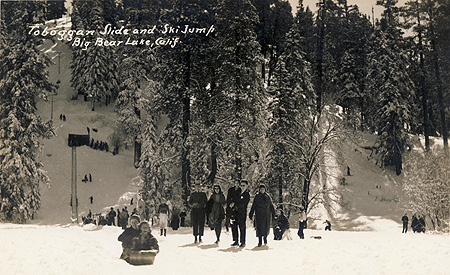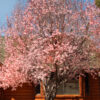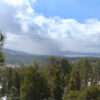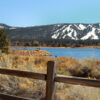Once known as “Yahuviat” or pine place to the Serrano Native Americans, the Big Bear Valley grew quickly after gold was discovered in the 1860’s. The stories that detail the experiences of the early pioneers are as diverse and fascinating as Big Bear itself. “Big Bear Valley” was the name given to this area when the first white men to enter the valley encountered grizzly bears residing here in great numbers. Big Bear Lake was formed when the first dam was constructed in 1884, and when a second dam was erected in 1910 it created the largest man made lake of its day.
The grizzly bears that gave the valley its name were gone by 1908 and by that time Big Bear was well on its way to becoming a resort destination for the city dwellers that lived below. The first hotel was built in 1888 to accommodate the miners and hunters that would endure the 2 day trek on horseback. In 1912 the Mountain Auto Line was established to bring freight and passengers to the mountains for the first time on a regular basis. Hotels and lodges began springing up throughout the valley and by the 1924 there were forty-four resorts in full operation.
Skiing was first introduced in Big Bear in the early 1930’s and the first ski lift was put into operation in 1938. In 1952, Snow Summit Ski Area was opened and Big Bear became a true four-season destination resort. Today, on any typical holiday weekend, the number of daily visitors can exceed 75,000 people, giving testament to the popularity of our sleepy little mountain getaway.
Big Bear has an alpine tundra climate and four distinct seasons, spring, summer, fall, and winter. Summer temperatures average from 47 to 80 degrees and winter temperatures average from 21 to 47 degrees. The highest temperature recorded at Big Bear was 94°F (34°C), recorded on July 15, 1998. The record lowest temperature was -25°F (-32°C), on January 29, 1979.
Snowfall, measured at the lake level, averages 61.8 inches each year with some seasons receiving record totals of over 100 inches. In February 1990, 59.5 inches (151 cm) of snow were recorded. The most snow in 24 hours was 27.0 inches (69 cm) on March 27, 1991. The greatest snow depth was 58 inches (147 cm) on February 3, 1979. Snow has fallen in Big Bear every month except July and August. There are normally 16.5 days each year with measurable snow.
If you take the time to get to know the locals, you’re going to fall in love with Big Bear CA. The year-round activities, the fresh air, the wildlife, and the small town feel of our mountain community are just a few of the obvious reasons to consider owning a piece of the Mountain. The real return on your investment will be in your family’s enjoyment and the quality of life that our area has to offer. We look forward to helping you make your Big Bear dreams become reality.







